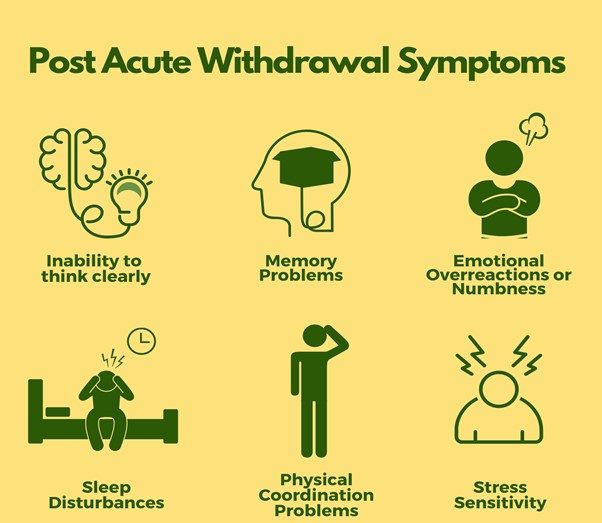
If you are thinking of quitting drugs and alcohol, you may or may not have heard of the term PAWS in relation to drug and alcohol withdrawal.
This article explores what PAWS means, who it affects, the signs and symptoms, its risks and dangers, and how to avoid getting PAWS. We also look at how to treat the symptoms.
Whilst post-acute withdrawal syndrome is not officially recognised by any medical association, this does not mean it does not exist. Having helped many individuals who suffer from drug and alcohol addiction to recover, we sometimes find that some patients experience protracted symptoms of withdrawal after the initial detoxification process. These symptoms usually only affect those that suffer from chronic drug and alcohol use.
Thankfully, the symptoms can be managed and treated. This is essential in achieving a healthy and happy recovery and in avoiding relapse.
PAWS stands for Post-Acute Withdrawal Syndrome and refers to a cluster of physical and mental health symptoms that can remain, develop, or come and go, well beyond the expected period of recovery.
Once a person has completed an initial detox from an addictive substance, they would naturally expect to feel much better. While for most people, this is true, some can continue to suffer distressing symptoms for weeks, months, or even years after having successfully stopped using drugs and alcohol.
The possibility of developing post-acute withdrawal syndrome can prove to be an obstacle for some chronic substance abusers to getting and staying clean. In some cases, symptoms can be so persistent that a person returns to using substances rather than continue to suffer. This is why it is important not to dismiss symptoms and look at effective ways of managing and treating the condition.
Whilst there are no official statistics on the number of people who experience PAWS. However, the condition is common enough to be recognised worldwide by professionals in addiction treatment and withdrawal management.
If you want to stop drinking and/or using, there are some things you can do that may help to reduce your chances of developing PAWS.
To prevent post-acute withdrawal syndrome, it is recommended that you consult with a doctor or addiction treatment professional. This way, you can ensure that you stop drinking and safely taking drugs with the least amount of stress to your body and mind.
If you have a heavy and/or long-standing drug or alcohol dependence, medical detox is clinically recommended. This involves regular medication being administered by a detox nurse, who will oversee the entire process to ensure your comfort and safety.
It is important to keep stress to a minimum during the period of rehabilitation. Eating well, supportive therapy, medication, rest and regular light exercise are all very helpful in combating the severity of withdrawal symptoms you experience.
Post-acute withdrawal syndrome tends to affect those that suffer from a chronic substance abuse disorder. There is really no telling who will and who won’t develop PAWS following on from detoxification. However, some indications make a person more likely to develop the disorder.

Whilst there is still no definite cause of development, scientists believe that the physiological changes that the brain sustains with prolonged substance abuse can be caused by the physiological changes that the brain sustains with prolonged substance abuse. The more damage caused to the brain’s neurotransmitters and pathways (which adapt to drug and alcohol dependence, and then again during detoxification), the less resilience the brain has in response to stress.
The recovering addict’s brain’s capability to deal with stress is compromised due to the brain’s neurotransmitters going into overdrive during early abstinence. This overactivity of the brain’s neurotransmitters affects how the brain communicates and can result in protracted withdrawal symptoms.
While PAWS can literally affect anyone trying to stop an addictive substance, it is most prevalent in those who abuse benzodiazepines, opiates, or alcohol. This can be attributed to these substances being CNS depressant drugs. Cessation of chronic use of CNS depressant drugs results in overexcitement of the brain whilst it scrambles to recalibrate.
Whilst the timeline will look different for everyone; there have been reports of benzodiazepine abusers suffering for years after complete cessation of the drug 1
It is challenging to predict if and when a particular person will develop post-acute withdrawal syndrome and how long they will be affected by it. The same applies to the severity of PAWS symptoms experienced.
Each person has their own individual biological make-up and experience of substance abuse. Because of this, the timeline and severity of Post-Acute Withdrawal Syndrome will look different for each person.
Whilst some may experience mild to severe symptoms for a short period, others may experience mild to severe symptoms for weeks, months, or even years after stopping drugs and alcohol.
Some symptoms may come and go, whilst others remain a constant. A person may also develop PAWS later in their recovery, not just a week or two after stopping the problem substance.
The severity of symptoms have been observed to increase with stress and exposure to stressful situations 1
Whilst there is no way of preventing PAWS or predicting who will suffer from it, it makes sense to help the brain during the recalibration process after stopping addictive substances. This will, at the very least, make symptoms less severe.
Abrupt cessation of drugs and alcohol where there is a longstanding, chronic dependence, or history of abuse, will naturally result in the most severe withdrawal symptoms and be very dangerous. This is particularly true of alcohol, benzodiazepines and opioids, which can induce life-threatening symptoms and inflict further damage to the brain during the withdrawal process.
Stress is an identified trigger for PAWS symptoms. It also makes sense to learn ways of effectively managing stress and keeping it to a minimum level wherever possible, especially during detoxification and early recovery.
If you or a loved one have a long-standing or chronic dependence on alcohol or drugs, residential treatment is strongly advised. With the assistance of approved pharmaceutical detox drugs, around the clock support and holistic stress reduction, the brain and body will be helped and supported throughout the detoxification process.
Equally as important in helping to reduce the risk for developing PAWS is ensuring that you receive the correct medical and therapeutic treatment for any dual diagnosis illnesses. This should ideally be undertaken simultaneously, along with a drug and alcohol rehabilitation programme.
How long you experience post-acute withdrawal syndrome will be personal and depend on your history of drug and alcohol abuse or addiction.
If you have a heavy chronic substance abuse problem, the brain can take 6 months up to 2 years to readjust to being substance-free fully. Addictive drugs such as benzodiazepines are notorious for requiring a protracted withdrawal process. Therefore PAWS related to benzodiazepine abuse is more common and tends to last longer.
If you are worried that you are continuing to suffer the symptoms for an excessively long period, it is always best to speak to a healthcare professional to rule out the possibility of any other causes 5
If you or a loved one suffer from PAWS, there is professional help and treatment available. A medication regularly used to aid alcoholics to recover, acamprosate, can sometimes be useful in managing symptoms. Whilst treatment is unlikely to eradicate symptoms, it can help you effectively manage and reduce their severity, making life much more manageable.
Suffering from PAWS can seem hopeless and feel like life is never going to get better. However, we can assure you that the symptoms do diminish and disappear over time and that you can assist the recovery process.

PAWS symptoms will eventually end, and they can be effectively managed with the right help and support. They are most definitely worth persisting through, and you do not have to do it alone.
Contact Rehab Guide for confidential help and advice on 02072052845.